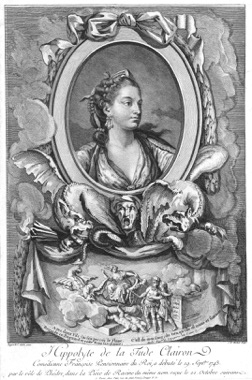The dossier of letters that makes up Part II of the Commentaire historique constitutes a recognition, for the first time from Voltaire himself, that his written correspondence was a vital part of his public image. This second part has been separated from the first in all republications of the text since 1777, so the OCV edition is the first to reunite the two parts and recognise them as interdependent. Part I also has a significant epistolary portion, as both Voltaire’s letters and those he has received are quoted and occasionally reproduced in full to provide evidence for assertions made by the third-person narration. The end result is a plurality of voices and genres that is archetypal of many of Voltaire’s works. This characteristic is taken to the extreme in Part II, which comprises an epistolary dossier of twenty-nine of the philosophe’s letters and two from his correspondents.

Mlle Clairon in Racine’s ‘Phèdre’.
Less typical is the selection of correspondents in Part II, an unusual mix that bears little resemblance to the recipients most frequently featured in his correspondence. Why has Voltaire presented a sample of his correspondence that looks nothing like his full correspondence as we know it? Harking back to brand management, the answer is most likely that Voltaire wishes to appear ‘in’ with a particular crowd. The recipients are largely aristocratic polymaths, possessing expertise that ranges from sculpture (Caylus) to ornithology (Faugères) via human anatomy (Le Cat). The sole female correspondent is Mlle Clairon, whose inclusion serves to remind readers that the heroine of the Comédie-Française was not only Voltaire’s close personal friend but had also starred in several of his plays. In short, the selection of correspondents is a humble brag: Voltaire wanted to appear as something of a big deal in high society. This has the effect of softening the philosophe’s controversial militant streak in a similar way to the omission of the radically anti-religious Lettres philosophiques from Part I.
‘I have been so exasperated, my dear friend, by my ingenious and gallant letters that I never wrote and so much other twaddle attributed to me, that I must be forgiven if I side with every cardinal, or every Pope that has had similar tricks played on him.’ (Letter 27)
(J’ai été si excédé, mon cher ami, de mes lettres ingénieuses et galantes que je n’ai jamais écrites et de tant d’autres fadaises à moi imputées, qu’il faut me pardonner si je prends le parti de tout cardinal, ou de tout pape à qui on joue de pareils tours.)
The subject of authenticity pervading the Commentaire historique culminates in Part II with the discussion of a collection of letters purporting to be by Pope Ganganelli (Clement XIV). Voltaire denounces these letters as obvious fakes and compares them to the forgery and unauthorised publication of his own letters. Elsewhere in Parts I and II Voltaire perpetually returns to the topic of forged letters and laments how he has recently fallen victim to this immoral practice. This begs the question: are the letters in the Commentaire historique themselves forgeries? The answer is that we cannot be sure, given that the majority of these letters had not been previously printed. For those that had been (Letters 1, 4, 6, 7, 9, 10 and 15), the alterations are slight. At the other end of the spectrum, it is certain that Letter 30 to the Lazzaro Spallanzani was rewritten to the point of forgery because Spallanzani himself found out and produced the original. For the other letters, comparison to the various manuscript sources available proves inconclusive. Some are not really even letters at all; they read more like essays and so bring into question the whole epistolary status of the dossier itself.
